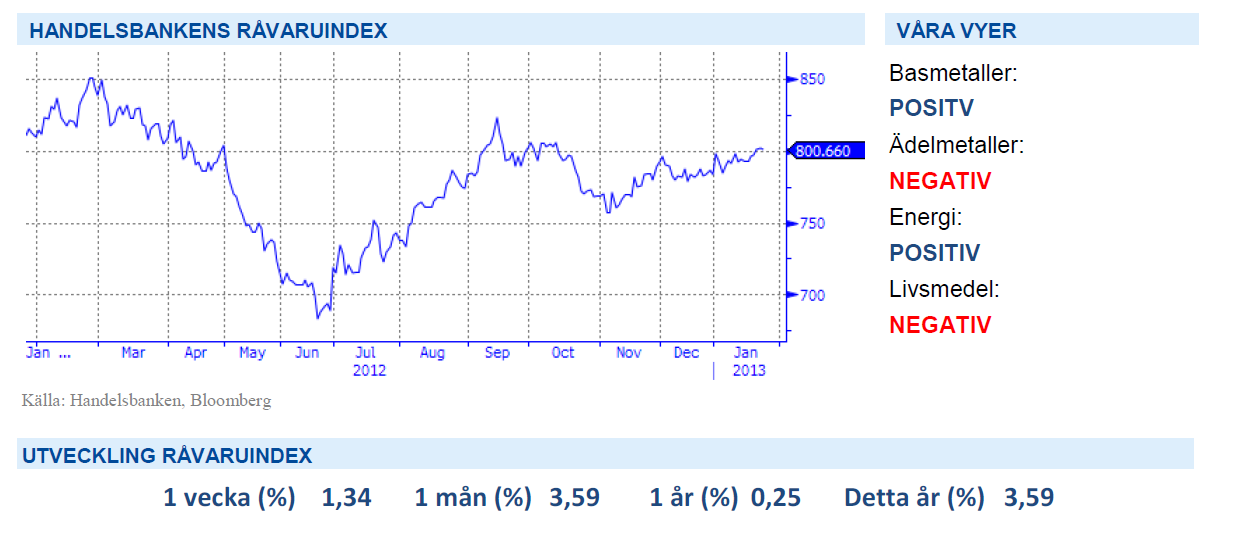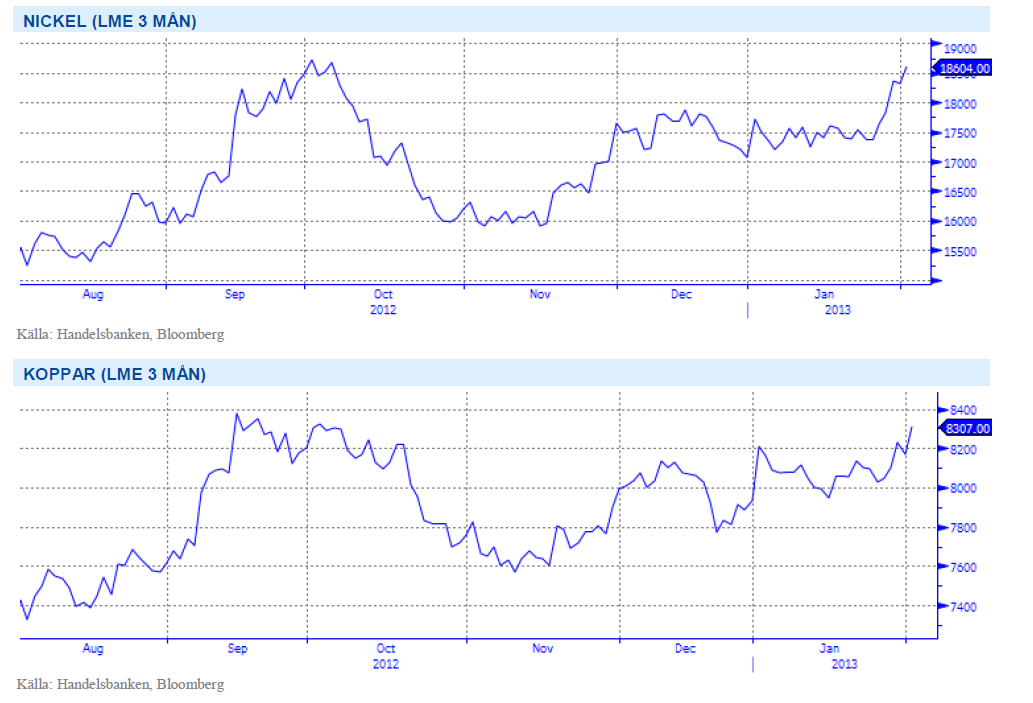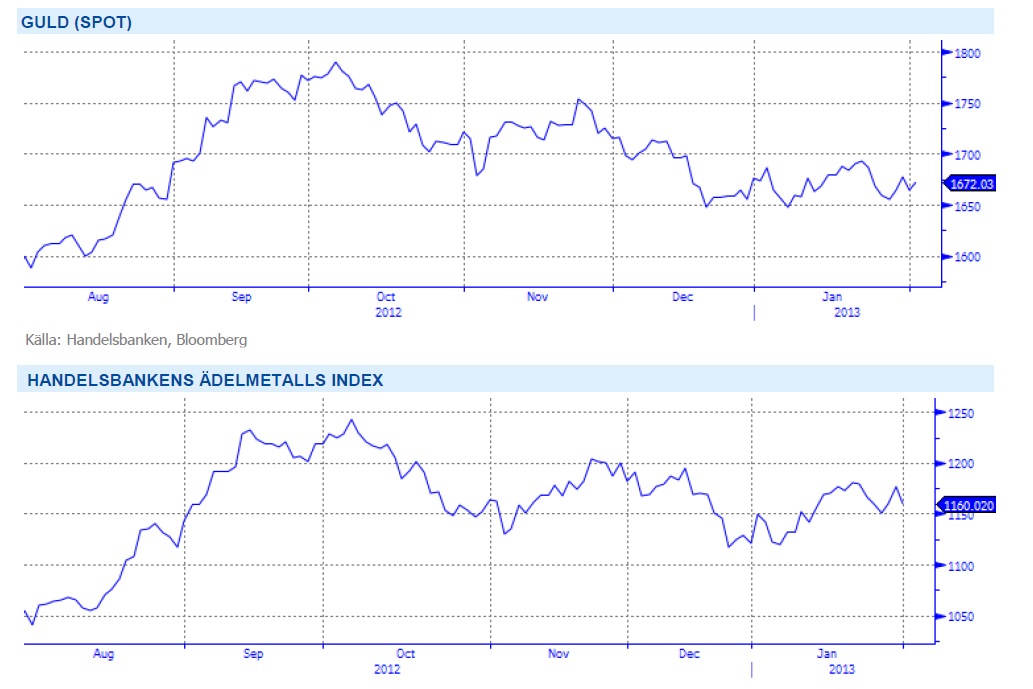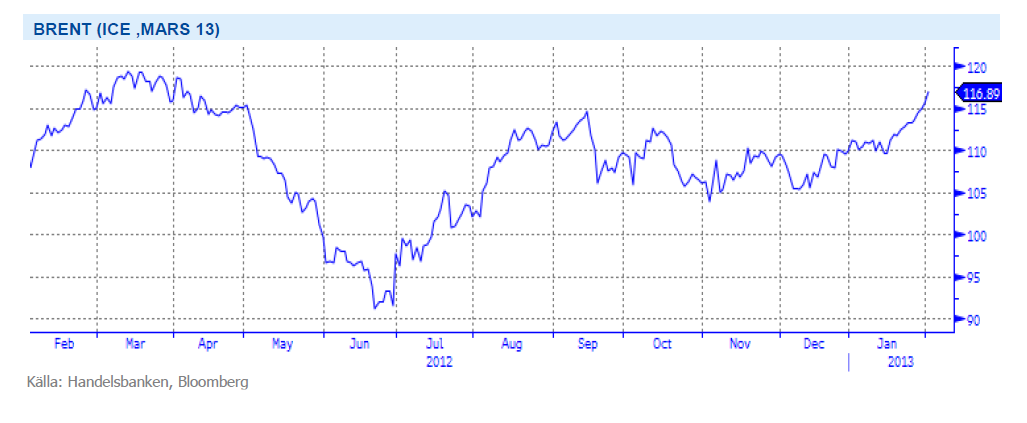Analys
SHB Råvarubrevet 1 februari 2013

 Råvaror Allmänt
Råvaror Allmänt
Risk On för råvaror
Årets starka inledning för aktiemarknader har nu börjat smitta av sig på råvaror. Under veckan har råvaror äntligen fått sitt genombrott och de konjunkturhandlade råvarorna basmetaller och olja klättrat så gott som varje dag. USA:s BNP för Q4 kom in svagare än väntat under onsdagen och fick guld att hoppa upp i tron att det förlänger penningpolitiska stimulanser i USA. Annars har guld fallit i takt med att investerare viktar om från defensiva positioner som guld till mer offensiva, konjunkturberoende positioner. Denna trend tror vi fortsätter och vi sänker därför Ädelmetaller till negativ och växlar upp Energi från neutral till positiv.
Under veckan fick vi också mer vatten på vår kvarn för fortsatt penningpolitisk stimulans i USA, den enskilt viktigaste faktorn för att hålla det positiva sentimentet uppe i världsekonomin just nu. Chefen för amerikanska centralbanken, Fed Ben Bernanke, signalerade att Fed inte är nära att minska stödköpen som sker för att stimulera ekonomin och minska arbetslösheten.
Basmetallerna
Ökad riskaptit gynnar basmetallerna
Basmetallerna lägger en vecka bakom sig med stigande priser, med uppgångar på 2-3 procent. Den metall som sticker ut är nickel som stigit med 6,6 % under veckan, den största ökningen på en vecka sedan november. På året har metallen stigit med hela 8,5 % och det främst ekonomisk data från Kina och USA som driver på uppgången.
Senaste veckan har koppar nått 3-månaders högsta som en följd av nyheter på snabbare ekonomisk tillväxt och vinsthemtagningar för kinesiska industribolag. Jobbsiffror som inte mötte förväntningar höll dock tillbaka uppgången något under fredagen. Kinas återhämtning från konjunkturnedgången går långsamt med säkert. De viktigaste indikatorerna pekar uppåt och BNP för Q4 såg för första gången på 10 kvartal bra ut. Den råvarusektor som är mest beroende av kinas återhämtning är basmetaller och till dessa är vi fortsatt positiva.
Den globala tillväxten har fått ny kraft och gynnar konjunkturkänsliga råvaror som basmetaller. Vi tror på: BASMET H
Ädelmetaller
Vi byter fot på guldet!
Efter att ha haft en positiv syn på ädelmetaller ända sedan Fed-chefens tal i Jackson Hole i slutet av augusti börjar vi nu bli betydligt mer tveksamma. Efter Jackson Hole har guldet som högst handlat drygt 8 procent upp, men har sedan toppen i början av oktober glidit lugnt men säkert nedåt. Under 2013 har guldet handlat mellan 1650 och 1700 dollar per uns, vilket är exakt samma nivåer som rådde i augusti.
Vår positiva syn sedan dess har byggt på två hörnstenar, nämligen den extrema stimulans som centralbanker världen över ägnar sig åt, och de stigande inflationsförväntningar som kommer med detta. Årets starka inledning på världens aktiemarknader, och de positiva konjunktursignaler vi fått, och det något minskade fokus som rått på euro-krisen gör att vi tror att det positiva risksentimentet fortsätter. Potentiellt stigande räntenivåer, fortsatt riskaptit kombinerat med utebliven prisuppgång på guldet får oss att tro att nästa stora rörelse kommer att vara nedåt.
Som alltid är timing på sådant här väldigt svårt, men en budgetuppgörelse i USA under februari tror vi kan vara en trigger för en större rörelse på nedsidan. Guldet befinner sig fortfarande på väldigt höga nivåer i ett historiskt perspektiv, varför vi känner oss bekväma att skifta vy 180 grader i detta läge.
Med fortsatt positivt risksentiment och potentiellt stigande räntenivåer ser vi nästa stora rörelse kommer att vara nedåt. Vi tror på GULD S H
Energi
Ökad riskaptit gynnar även oljan
Brent-oljan har handlats i en uppåtgående trend i över 2 veckor och handlas nu över 117-nivån, en nivå vi inte sett sedan mitten av april. Torsdagens löfte från amerikanska centralbanken att fortsätta sina obligationsköp samt positiv makrodata från euroområdet ger ökad riskaptit vilket gynnar oljan. Oljemarknaden stabiliseras av att Saudi nu sänker produktionen för att stabilisera priset. Den säsongsmässigt starka delen av året ligger också framför oss när det gäller oljekonsumtion. Utsläppsrätterna avslutar veckan i princip oförändrad efter kraftig uppgång under fredagen. Det var efter Angela Merkels uttalande att hon stödjer backloadingplanen (en plan för att minska överskott av rätter, ca 30 % till 2015) som priset snabbt steg 30 % och därmed raderade veckans tidigare nedgång.
Som vi tidigare skrivit är det svårt att se hur EU Kommissionen skall agera kring tilldelning och balans för att undvika att förtroendet för marknaden urholkas helt för all framtid. Vidare det mer grundläggande problemet kring svårigheten att få till ett globalt direktiv där man involverar USA och tillväxtmarknaderna vilket är det enda som ger stöd och mening åt den europeiska marknaden. Elmarknaden handlas i stort sett oförändrat över veckan. Då kontinentala elpriser och det tyska i synnerhet är lågt bör det finnas utrymme för nordisk att falla något till från dagens nivå om 35 euro. Vi förväntar oss dock inga större rörelser utan att det mesta diskonterats för varför vi ändrat vår syn från kort till neutral. Inte omöjligt att vi kanske t.o.m får se en liten tillfällig uppgång om det kalla och torra vädret som givit stöd denna vecka består vilket påverkar en redan försvagad energibalans. Prognoserna visar idag att vi får en normal utveckling på slutet av tio dagars perioden.
Den råvarugrupp som är mest beroende av den globala konjunkturen är Energi och med en starkare konjunktur ser vi positivt på utvecklingen för denna sektor. Vi tror på: ENERGI H
Livsmedel
Försämrat skick på det amerikanska vetet
Priset på vete är svagt upp denna vecka. Än är det torrt och varmt för det amerikanska höstvetet, vilket gör att skicket på grödan fortsätter att försämras. I december månad var låga 25 procent av höstvetet i delstaten Kansas i skicket good/excellent, idag uppskattas samma siffra till rekordlåga 20 procent – vid samma tid förra året var motsvarande siffra mer normala 45 procent. Torrt väder väntas även nästa vecka och det kommer verkligen behövas en gynnsam vår för att grödorna ska återhämta sig någorlunda.
I EU bedöms allt fortfarande vara helt ok, generellt sett bra med snö och varmare temperaturer. I en del områden har snön regnat bort men temperaturen är relativt hög och ser ut att förbli så framöver. I Ukraina steg temperaturen något i slutet av veckan men än finns det generellt sett gott om skyddande snö kvar om kylan återvänder. I Ryssland uppges allt vara ok, beräknad utvintring ligger omkring 10 procent vilket är ganska normalt. Kanadas totala veteareal väntas nå 25,3 miljoner acres, upp från förra årets 23,8 miljoner acres. Höstvetet i USA är alltså i riktigt dåligt skick och någon klar förbättring är inte i sikte. I andra veteregioner i världen råder dock inga större problem vilket håller tillbaka en prisuppgång. Än finns det dessutom tid för regn att falla inför sådd av majs i USA – vilket spannmålsmarknaden kommer lägga stort fokus på under kommande veckor. Givet inga större väderproblem bör vi dock vänta oss fallande priser lite längre fram på året.
Vi ser fortfarande framför oss fallande priser på livsmedelsektor på lite längre sikt. Vi tror på: LIVSMEDEL S H
Handelsbankens Råvaruindex
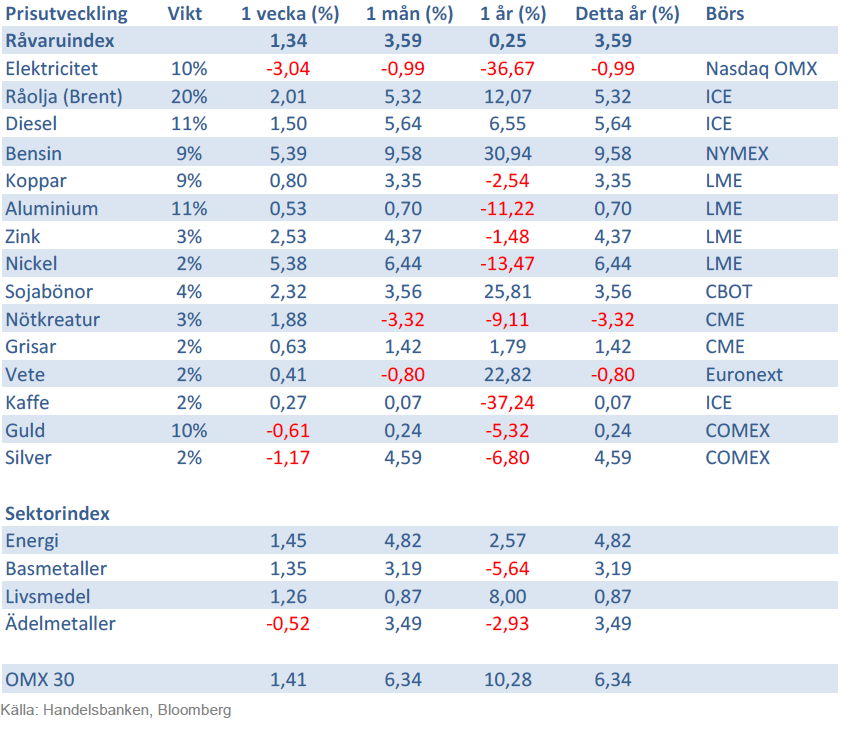
Handelsbankens råvaruindex består av de underliggande indexen för respektive råvara. Vikterna är bestämda till hälften från värdet av global produktion och till hälften från likviditeten i terminskontrakten.
[box]SHB Råvarubrevet är producerat av Handelsbanken och publiceras i samarbete och med tillstånd på Råvarumarknaden.se[/box]
Ansvarsbegränsning
Detta material är producerat av Svenska Handelsbanken AB (publ) i fortsättningen kallad Handelsbanken. De som arbetar med innehållet är inte analytiker och materialet är inte oberoende investeringsanalys. Innehållet är uteslutande avsett för kunder i Sverige. Syftet är att ge en allmän information till Handelsbankens kunder och utgör inte ett personligt investeringsråd eller en personlig rekommendation. Informationen ska inte ensamt utgöra underlag för investeringsbeslut. Kunder bör inhämta råd från sina rådgivare och basera sina investeringsbeslut utifrån egen erfarenhet.
Informationen i materialet kan ändras och också avvika från de åsikter som uttrycks i oberoende investeringsanalyser från Handelsbanken. Informationen grundar sig på allmänt tillgänglig information och är hämtad från källor som bedöms som tillförlitliga, men riktigheten kan inte garanteras och informationen kan vara ofullständig eller nedkortad. Ingen del av förslaget får reproduceras eller distribueras till någon annan person utan att Handelsbanken dessförinnan lämnat sitt skriftliga medgivande. Handelsbanken ansvarar inte för att materialet används på ett sätt som strider mot förbudet mot vidarebefordran eller offentliggörs i strid med bankens regler.
Analys
More weakness and lower price levels ahead, but the world won’t drown in oil in 2026

Some rebound but not much. Brent crude rebounded 1.5% yesterday to $65.47/b. This morning it is inching 0.2% up to $65.6/b. The lowest close last week was on Thursday at $64.11/b.

The curve structure is almost as week as it was before the weekend. The rebound we now have gotten post the message from OPEC+ over the weekend is to a large degree a rebound along the curve rather than much strengthening at the front-end of the curve. That part of the curve structure is almost as weak as it was last Thursday.
We are still on a weakening path. The message from OPEC+ over the weekend was we are still on a weakening path with rising supply from the group. It is just not as rapidly weakening as was feared ahead of the weekend when a quota hike of 500 kb/d/mth for November was discussed.
The Brent curve is on its way to full contango with Brent dipping into the $50ies/b. Thus the ongoing weakening we have had in the crude curve since the start of the year, and especially since early June, will continue until the Brent crude oil forward curve is in full contango along with visibly rising US and OECD oil inventories. The front-month Brent contract will then flip down towards the $60/b-line and below into the $50ies/b.
At what point will OPEC+ turn to cuts? The big question then becomes: When will OPEC+ turn around to make some cuts? At what (price) point will they choose to stabilize the market? Because for sure they will. Higher oil inventories, some more shedding of drilling rigs in US shale and Brent into the 50ies somewhere is probably where the group will step in.
There is nothing we have seen from the group so far which indicates that they will close their eyes, let the world drown in oil and the oil price crash to $40/b or below.
The message from OPEC+ is also about balance and stability. The world won’t drown in oil in 2026. The message from the group as far as we manage to interpret it is twofold: 1) Taking back market share which requires a lower price for non-OPEC+ to back off a bit, and 2) Oil market stability and balance. It is not just about 1. Thus fretting about how we are all going to drown in oil in 2026 is totally off the mark by just focusing on point 1.
When to buy cal 2026? Before Christmas when Brent hits $55/b and before OPEC+ holds its last meeting of the year which is likely to be in early December.
Brent crude oil prices have rebounded a bit along the forward curve. Not much strengthening in the structure of the curve. The front-end backwardation is not much stronger today than on its weakest level so far this year which was on Thursday last week.

The front-end backwardation fell to its weakest level so far this year on Thursday last week. A slight pickup yesterday and today, but still very close to the weakest year to date. More oil from OPEC+ in the coming months and softer demand and rising inventories. We are heading for yet softer levels.

Analys
A sharp weakening at the core of the oil market: The Dubai curve

Down to the lowest since early May. Brent crude has fallen sharply the latest four days. It closed at USD 64.11/b yesterday which is the lowest since early May. It is staging a 1.3% rebound this morning along with gains in both equities and industrial metals with an added touch of support from a softer USD on top.

What stands out the most to us this week is the collapse in the Dubai one to three months time-spread.
Dubai is medium sour crude. OPEC+ is in general medium sour crude production. Asian refineries are predominantly designed to process medium sour crude. So Dubai is the real measure of the balance between OPEC+ holding back or not versus Asian oil demand for consumption and stock building.
A sharp weakening of the front-end of the Dubai curve. The front-end of the Dubai crude curve has been holding out very solidly throughout this summer while the front-end of the Brent and WTI curves have been steadily softening. But the strength in the Dubai curve in our view was carrying the crude oil market in general. A source of strength in the crude oil market. The core of the strength.
The now finally sharp decline of the front-end of the Dubai crude curve is thus a strong shift. Weakness in the Dubai crude marker is weakness in the core of the oil market. The core which has helped to hold the oil market elevated.
Facts supports the weakening. Add in facts of Iraq lifting production from Kurdistan through Turkey. Saudi Arabia lifting production to 10 mb/d in September (normal production level) and lifting exports as well as domestic demand for oil for power for air con is fading along with summer heat. Add also in counter seasonal rise in US crude and product stocks last week. US oil stocks usually decline by 1.3 mb/week this time of year. Last week they instead rose 6.4 mb/week (+7.2 mb if including SPR). Total US commercial oil stocks are now only 2.1 mb below the 2015-19 seasonal average. US oil stocks normally decline from now to Christmas. If they instead continue to rise, then it will be strongly counter seasonal rise and will create a very strong bearish pressure on oil prices.
Will OPEC+ lift its voluntary quotas by zero, 137 kb/d, 500 kb/d or 1.5 mb/d? On Sunday of course OPEC+ will decide on how much to unwind of the remaining 1.5 mb/d of voluntary quotas for November. Will it be 137 kb/d yet again as for October? Will it be 500 kb/d as was talked about earlier this week? Or will it be a full unwind in one go of 1.5 mb/d? We think most likely now it will be at least 500 kb/d and possibly a full unwind. We discussed this in a not earlier this week: ”500 kb/d of voluntary quotas in October. But a full unwind of 1.5 mb/d”
The strength in the front-end of the Dubai curve held out through summer while Brent and WTI curve structures weakened steadily. That core strength helped to keep flat crude oil prices elevated close to the 70-line. Now also the Dubai curve has given in.

Brent crude oil forward curves

Total US commercial stocks now close to normal. Counter seasonal rise last week. Rest of year?

Total US crude and product stocks on a steady trend higher.

Analys
OPEC+ will likely unwind 500 kb/d of voluntary quotas in October. But a full unwind of 1.5 mb/d in one go could be in the cards

Down to mid-60ies as Iraq lifts production while Saudi may be tired of voluntary cut frugality. The Brent December contract dropped 1.6% yesterday to USD 66.03/b. This morning it is down another 0.3% to USD 65.8/b. The drop in the price came on the back of the combined news that Iraq has resumed 190 kb/d of production in Kurdistan with exports through Turkey while OPEC+ delegates send signals that the group will unwind the remaining 1.65 mb/d (less the 137 kb/d in October) of voluntary cuts at a pace of 500 kb/d per month pace.

Signals of accelerated unwind and Iraqi increase may be connected. Russia, Kazakhstan and Iraq were main offenders versus the voluntary quotas they had agreed to follow. Russia had a production ’debt’ (cumulative overproduction versus quota) of close to 90 mb in March this year while Kazakhstan had a ’debt’ of about 60 mb and the same for Iraq. This apparently made Saudi Arabia angry this spring. Why should Saudi Arabia hold back if the other voluntary cutters were just freeriding? Thus the sudden rapid unwinding of voluntary cuts. That is at least one angle of explanations for the accelerated unwinding.
If the offenders with production debts then refrained from lifting production as the voluntary cuts were rapidly unwinded, then they could ’pay back’ their ’debts’ as they would under-produce versus the new and steadily higher quotas.
Forget about Kazakhstan. Its production was just too far above the quotas with no hope that the country would hold back production due to cross-ownership of oil assets by international oil companies. But Russia and Iraq should be able to do it.
Iraqi cumulative overproduction versus quotas could reach 85-90 mb in October. Iraq has however steadily continued to overproduce by 3-5 mb per month. In July its new and gradually higher quota came close to equal with a cumulative overproduction of only 0.6 mb that month. In August again however its production had an overshoot of 100 kb/d or 3.1 mb for the month. Its cumulative production debt had then risen to close to 80 mb. We don’t know for September yet. But looking at October we now know that its production will likely average close to 4.5 mb/d due to the revival of 190 kb/d of production in Kurdistan. Its quota however will only be 4.24 mb/d. Its overproduction in October will thus likely be around 250 kb/d above its quota with its production debt rising another 7-8 mb to a total of close to 90 mb.
Again, why should Saudi Arabia be frugal while Iraq is freeriding. Better to get rid of the voluntary quotas as quickly as possible and then start all over with clean sheets.
Unwinding the remaining 1.513 mb/d in one go in October? If OPEC+ unwinds the remaining 1.513 mb/d of voluntary cuts in one big go in October, then Iraq’s quota will be around 4.4 mb/d for October versus its likely production of close to 4.5 mb/d for the coming month..
OPEC+ should thus unwind the remaining 1.513 mb/d (1.65 – 0.137 mb/d) in one go for October in order for the quota of Iraq to be able to keep track with Iraq’s actual production increase.
October 5 will show how it plays out. But a quota unwind of at least 500 kb/d for Oct seems likely. An overall increase of at least 500 kb/d in the voluntary quota for October looks likely. But it could be the whole 1.513 mb/d in one go. If the increase in the quota is ’only’ 500 kb/d then Iraqi cumulative production will still rise by 5.7 mb to a total of 85 mb in October.
Iraqi production debt versus quotas will likely rise by 5.7 mb in October if OPEC+ only lifts the overall quota by 500 kb/d in October. Here assuming historical production debt did not rise in September. That Iraq lifts its production by 190 kb/d in October to 4.47 mb/d (August level + 190 kb/d) and that OPEC+ unwinds 500 kb/d of the remining quotas in October when they decide on this on 5 October.

-

 Nyheter4 veckor sedan
Nyheter4 veckor sedanKinas elproduktion slog nytt rekord i augusti, vilket även kolkraft gjorde
-

 Nyheter4 veckor sedan
Nyheter4 veckor sedanTyskland har så höga elpriser att företag inte har råd att använda elektricitet
-

 Nyheter4 veckor sedan
Nyheter4 veckor sedanDet stigande guldpriset en utmaning för smyckesköpare
-

 Nyheter3 veckor sedan
Nyheter3 veckor sedanOPEC+ missar produktionsmål, stöder oljepriserna
-

 Nyheter3 veckor sedan
Nyheter3 veckor sedanEtt samtal om guld, olja, fjärrvärme och förnybar energi
-

 Analys4 veckor sedan
Analys4 veckor sedanBrent crude ticks higher on tension, but market structure stays soft
-

 Analys3 veckor sedan
Analys3 veckor sedanAre Ukraine’s attacks on Russian energy infrastructure working?
-

 Nyheter2 veckor sedan
Nyheter2 veckor sedanGuld nära 4000 USD och silver 50 USD, därför kan de fortsätta stiga


